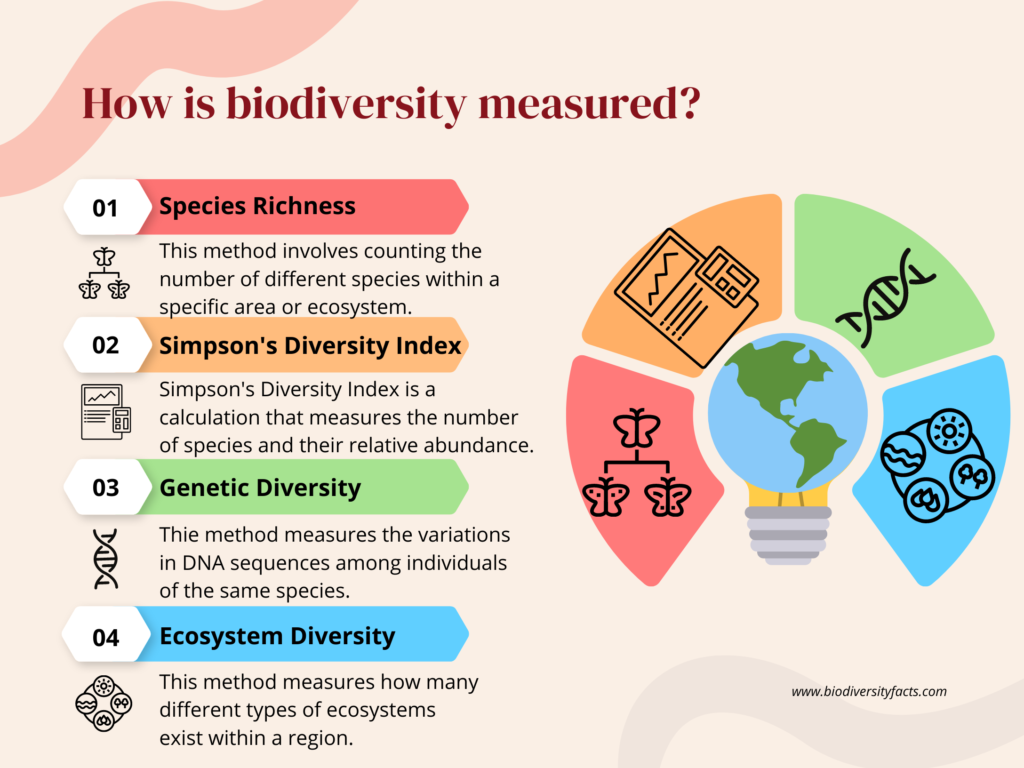Biodiversity, the incredible variety of life on Earth, is a critical aspect of our planet’s health and resilience. It encompasses the array of species, ecosystems, and genetic diversity that interconnect to form a complex web of life. Measuring biodiversity is essential for understanding the health of ecosystems, tracking changes over time, and implementing effective conservation strategies. In this article, we will delve into the methods used to measure biodiversity, shedding light on the simple yet crucial techniques that scientists employ.
Background Information: What Is Biodiversity and Why Is It So Important?
How Is Diversity Measured? 4 Techniques
There are four key ways that biodiversity can be measured. The first two, species richness and Simpson’s Diversity Index, measure the diversity of species types within a specific location or ecosystem. Measuring genetic diversity, on the other hand, measures the diversity within a specific species. Finally, ecosystem diversity measures how many different types of ecosystems exist in a certain area.

1. Species Richness: Counting the Species
One of the most straightforward ways to measure biodiversity is by counting the number of different species within a specific area or ecosystem. This metric is known as “species richness.” Scientists venture into various habitats, from rainforests to coral reefs, and meticulously document each unique species they encounter. The greater the number of distinct species, the higher the biodiversity of that area.
For instance, a meadow with a diverse array of flowering plants, insects, birds, and small mammals would likely have higher species richness compared to a monoculture agricultural field with limited species diversity.
2. Simpson’s Diversity Index: Going Beyond Counting
While species richness provides valuable information, it doesn’t capture the relative abundance of each species in a specific place. Simpson’s Diversity Index takes into account both the number of species and their relative abundances. This index assigns a value between 0 and 1, where 0 represents infinite diversity and 1 represents no diversity (only one species present).
Put more simply, Simpson’s Diversity Index is like a special calculator that helps us figure out how diverse or varied a group of things, like animals or plants, is in a particular place. It looks at a collection of different species and tries to tell which one is more common and which ones are rarer. The calculator looks at how many of each type of species there are and gives us a number that shows if the species are all the same or if there’s a big mix. If the number is closer to 1, it means there’s not much variety, but if it’s closer to 0, it tells us that there’s a big mix of species. In nature, this helps scientists understand if an area has lots of different living things or just a few dominating ones.
3. Genetic Diversity: Diversity within Species
Biodiversity also extends to the genetic level within individual species. Genetic diversity is essential for a species’ ability to adapt to changing environmental conditions. This diversity is measured by analyzing the variations in DNA sequences among individuals of the same species. Techniques like DNA sequencing provide insights into genetic differences and similarities, helping scientists understand population dynamics and potential vulnerabilities.
4. Ecosystem Diversity: Beyond the Species
Beyond species and genetic diversity, ecosystems themselves play a vital role in biodiversity. Ecosystem diversity considers the different types of habitats present in a given area. From forests and wetlands to deserts and oceans, each ecosystem contributes to overall biodiversity.
Measuring ecosystem diversity involves mapping out the different types of ecosystems within a region and assessing their health. Factors like the number of unique habitats, species composition, and ecological interactions are considered when evaluating ecosystem diversity.
Scaling Up Biodiversity Assessment: Remote Sensing and Technology
Advancements in technology have revolutionized the way we measure biodiversity, especially on a larger scale. Remote sensing tools, such as satellite imagery and drones, allow scientists to monitor changes in ecosystems from a distance. These tools help identify habitat loss, deforestation, and other changes that impact biodiversity.
Additionally, citizen science projects and online platforms have democratized biodiversity data collection. Enthusiastic volunteers and nature enthusiasts contribute observations of species through apps and websites, expanding the reach of biodiversity monitoring efforts.
Measuring biodiversity is not just an academic pursuit; it’s a critical tool for understanding the health of our planet and guiding conservation efforts. From species richness to genetic diversity, and from ecosystems to technological innovations, various methods offer insights into the intricate web of life. By applying these techniques – and developing new measuring techniques through new methods for gathering data – scientists and conservationists gain a clearer picture of the challenges and opportunities for preserving Earth’s biodiversity.